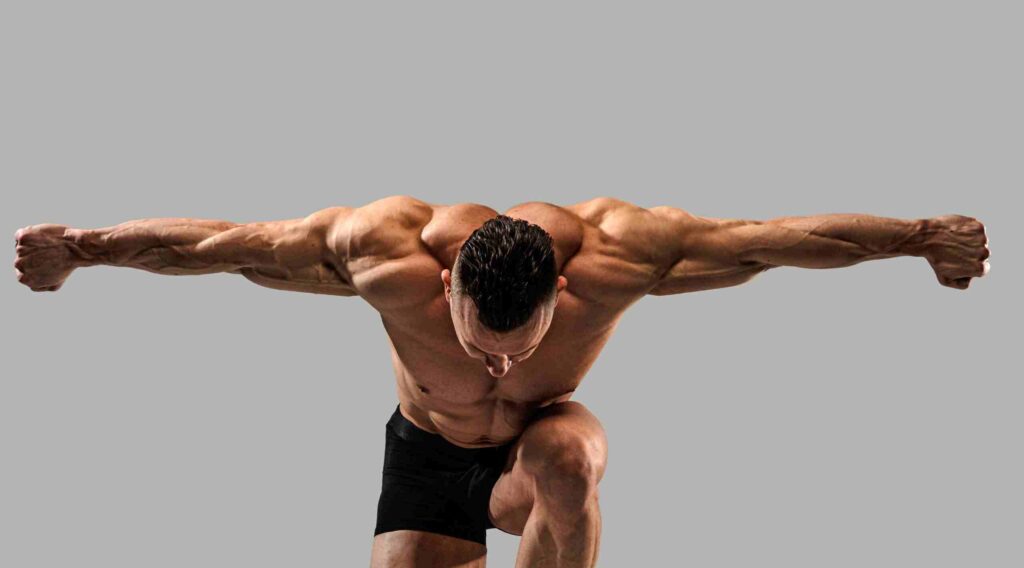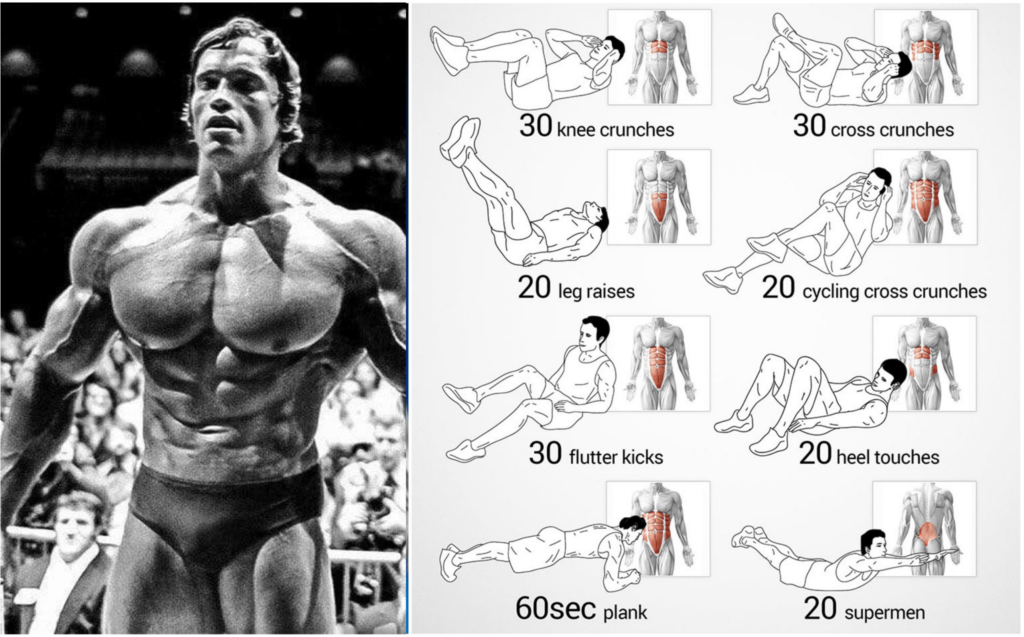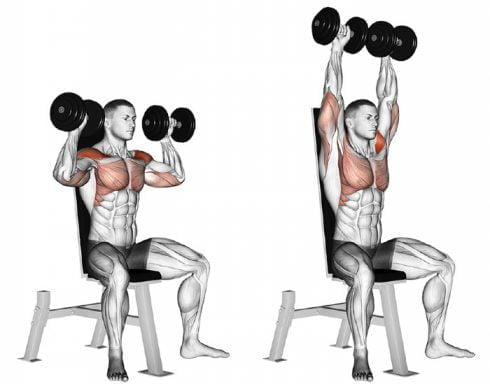Introduction

Advanced techniques for muscle growth are crucial for individuals who aim to maximize their muscular development. While traditional muscle growth techniques lay the foundation, advanced techniques take it a step further by providing innovative and scientifically backed strategies to optimize muscle hypertrophy. These advanced techniques allow individuals to break through plateaus, challenge their muscles in new ways, and achieve greater gains in size, strength, and overall muscular development.
Factors Influencing Muscle Growth
Several factors play a role in muscle growth, and understanding them is essential for implementing effective advanced techniques. These factors include:
- Progressive Overload: Gradually increasing the intensity, volume, or resistance in training to continually challenge the muscles and stimulate growth.
- Nutrition and Supplementation: Consuming a well-balanced diet rich in protein, carbohydrates, and healthy fats provides the necessary building blocks for muscle growth. Additionally, strategic supplementation can support muscle repair and recovery.
- Hormonal Balance: Hormones like testosterone, growth hormone, and insulin-like growth factor (IGF-1) contribute to muscle growth. Optimizing hormone levels through lifestyle choices, such as quality sleep and stress management, can enhance muscle-building potential.
- Recovery and Rest: Allowing adequate time for muscle recovery is vital for growth. Sleep, rest days, and proper post-workout nutrition are key components of the recovery process.
- Genetics: Genetic factors influence an individual’s potential for muscle growth and response to training. While genetics can play a role, advanced techniques can help individuals maximize their genetic potential.
Overview of traditional muscle growth techniques
Traditional muscle growth techniques form the foundation for advanced techniques. These techniques include:
- Resistance Training: Using weights, machines, or bodyweight exercises to create resistance and stimulate muscle growth. This typically involves exercises like squats, deadlifts, bench presses, and pull-ups.
- Hypertrophy Training: Focusing on moderate to high repetitions (8-12 reps) with moderate weights to induce muscle hypertrophy. This stimulates the muscle fibers to adapt and grow.
- Compound Movements: Incorporating multi-joint exercises that engage multiple muscle groups simultaneously, allowing for efficient muscle stimulation and overall strength development.
- Proper Form and Technique: Emphasizing correct exercise form to ensure optimal muscle activation, reduce the risk of injury, and maximize the effectiveness of each movement.
- Progressive Overload: Gradually increasing the training stimulus by adding weight, increasing repetitions, or reducing rest periods to continuously challenge the muscles.
SHOP FOR THE BEST ADJUSTABLE DUMBBELL SET ON AMAZON
By combining the principles of traditional muscle growth techniques with advanced strategies, individuals can create a comprehensive approach that optimizes muscle growth and helps them achieve their desired physique.
Nutrition and Supplementation for Muscle Growth

Advanced Techniques for Muscle Growth involve optimizing macronutrient intake to support optimal muscle growth. This includes consuming adequate amounts of protein, carbohydrates, and healthy fats. By carefully balancing these macronutrients, individuals can provide their bodies with the necessary fuel and building blocks for muscle hypertrophy.
Role of protein synthesis in muscle hypertrophy
Protein synthesis plays a crucial role in muscle hypertrophy, a key aspect of Advanced Techniques for Muscle Growth. During protein synthesis, amino acids from dietary protein are utilized to repair and rebuild muscle tissues damaged during exercise. By promoting protein synthesis through proper nutrition and resistance training, individuals can enhance muscle growth and recovery.
Timing and frequency of meals for muscle growth
Advanced Techniques for Muscle Growth emphasize the importance of strategic meal timing and frequency. Consuming regular meals and snacks throughout the day helps maintain a steady supply of nutrients for muscle repair and growth. Furthermore, strategically timing nutrient intake around workouts, such as consuming a balanced meal or protein-rich snack before and after exercise, can enhance muscle protein synthesis and optimize muscle growth.
The importance of proper hydration
Hydration is a critical yet often overlooked aspect of Advanced Techniques for Muscle Growth. Proper hydration is essential for optimal performance, nutrient delivery to muscles, and overall recovery. Staying adequately hydrated supports muscle function, prevents fatigue, and ensures efficient nutrient uptake, all of which are crucial for maximizing muscle growth and performance.
Effective muscle-building supplements and their benefits
While supplements should not replace a well-balanced diet, they can complement Advanced Techniques for Muscle Growth. Certain supplements have been shown to enhance muscle growth, strength, and recovery. Examples include whey protein, creatine monohydrate, branched-chain amino acids (BCAAs), and beta-alanine. These supplements can provide additional support for muscle growth and performance when used in conjunction with proper nutrition and training.
SHOP FOR THE WHEY PROTEIN POWDER ON AMAZON
Remember, incorporating advanced techniques for muscle growth requires a holistic approach that combines nutrition, training, and supplementation. It’s important to consult with a healthcare professional or registered dietitian before implementing any advanced techniques or introducing supplements to ensure they align with your individual goals and health needs.
Hormonal Optimization for Muscle Growth
Hormonal Optimization for Muscle Growth refers to strategies and techniques aimed at enhancing the body’s natural hormone levels to maximize muscle development and strength gains. This approach recognizes the significant impact hormones such as testosterone and growth hormone have on muscle growth.
A. The role of testosterone and growth hormone in muscle growth
Testosterone and growth hormone play crucial roles in muscle growth. Testosterone promotes protein synthesis and increases muscle mass and strength. Growth hormone stimulates cell reproduction and regeneration, aiding in muscle recovery and growth.
B. Natural ways to optimize hormone levels for muscle gains
To optimize hormone levels for muscle gains, focus on:
- Resistance training: Engage in compound exercises, heavy lifting, and high-intensity workouts, as they can stimulate testosterone and growth hormone production.
- Adequate sleep: Ensure you get enough quality sleep, as sleep deprivation can negatively impact hormone levels, including testosterone.
- Balanced nutrition: Consume a well-rounded diet with sufficient protein, healthy fats, and complex carbohydrates. Adequate calorie intake is essential to support hormone production.
- Vitamin D: Maintain optimal levels of vitamin D, as it is linked to testosterone production. Spend time outdoors or consider vitamin D supplements if necessary.
C. Understanding the impact of stress and cortisol on muscle growth
Excessive stress and elevated cortisol levels can hinder muscle growth. High cortisol levels can lead to muscle breakdown and inhibit protein synthesis. To manage stress and cortisol:
- Practice stress-reducing techniques: Incorporate stress management techniques like meditation, deep breathing exercises, and yoga into your routine.
- Adequate recovery: Allow sufficient time for rest and recovery between workouts to minimize stress on the body.
- Manage lifestyle factors: Prioritize work-life balance, maintain healthy relationships, and engage in activities you enjoy to reduce overall stress levels.
D. Supplements and lifestyle factors that support hormonal balance
Certain supplements and lifestyle factors can support hormonal balance:
- Omega-3 fatty acids: Omega-3 supplements or foods rich in these healthy fats can help regulate hormone levels.
- Zinc and magnesium: These minerals play a role in testosterone production. Ensure adequate intake through supplementation or foods like oysters, nuts, and seeds.
- Avoid excessive alcohol consumption: Alcohol can disrupt hormone production and negatively impact muscle growth.
- Reduce exposure to endocrine disruptors: Minimize exposure to chemicals found in plastics, pesticides, and certain personal care products, as they can interfere with hormone balance.
SHOP FOR THE OMEGA-3 FATTY ACIDS SUPPLEMENT ON AMAZON
Remember, before incorporating any supplements or making significant changes to your lifestyle, it’s always wise to consult with a healthcare professional or a registered dietitian who specializes in sports nutrition to ensure it aligns with your individual needs and goals.
Advanced Muscle-Building Strategies

When it comes to advancing your muscle-building efforts, there are several strategies that can take your progress to the next level. Here are four key techniques to consider:
A. Cluster sets and intraset stretching techniques
Cluster sets are advanced training techniques used for muscle growth. In a cluster set, you perform a set of repetitions with a heavy load, but instead of performing all the repetitions consecutively, you take short rest intervals between subsets of repetitions. This allows you to maintain a high level of intensity throughout the set, leading to increased muscle fiber recruitment and fatigue.
Intraset stretching techniques involve incorporating stretching movements during your sets to enhance muscle growth. For example, you can perform a set of bicep curls and at the bottom of each repetition, hold the stretched position for a few seconds before proceeding with the next repetition. This technique stimulates the muscle fibers through a combination of tension and stretch, promoting muscle hypertrophy.
B. Blood flow restriction (BFR) training and its benefits
Blood flow restriction (BFR) training is an advanced technique that involves using a specialized tourniquet or elastic bands to restrict blood flow to the working muscles during exercise. By occluding venous return while allowing arterial blood flow, BFR training creates metabolic stress in the muscles, leading to increased muscle protein synthesis and growth. This technique is particularly useful for individuals who may have limitations in using heavy loads or who are recovering from injuries.
Some benefits of BFR training include enhanced muscle hypertrophy, improved strength gains, and the ability to achieve similar muscle growth results with lighter weights. However, it is crucial to learn proper BFR training protocols and seek guidance from a qualified professional to ensure safety and effectiveness.
C. Myofascial release techniques for muscle growth
Myofascial release techniques involve applying pressure to the fascia, and the connective tissue surrounding muscles, to release tension, improve flexibility, and promote muscle growth. Techniques such as foam rolling, massage therapy, and using specialized tools like lacrosse balls or massage sticks can target specific muscle groups and alleviate muscle tightness or trigger points. By improving the quality of the fascia, myofascial release techniques can enhance muscle function, range of motion, and ultimately support muscle growth.
D. Neuromuscular activation and mind-muscle connection
Neuromuscular activation refers to the ability to recruit and engage the targeted muscle effectively during exercise. Developing a strong mind-muscle connection is crucial for maximizing muscle growth. By consciously focusing on contracting and activating the specific muscle group you are working on, you can ensure that the muscle is being properly stimulated and engaged during each repetition. This technique enhances muscle fiber recruitment, motor unit activation, and overall muscle development. Techniques such as visualization, concentration, and focusing on muscle contraction can help strengthen the mind-muscle connection and optimize muscle growth.
Remember, these advanced techniques should be implemented with caution and under proper guidance to ensure safety and maximize their benefits.
Psychological Strategies for Muscle Growth
Psychological strategies play a crucial role in maximizing muscle growth and achieving optimal results. Here are some advanced techniques for muscle growth that focus on the psychological aspects:
- Mindset and Motivation: Cultivating a positive mindset and maintaining high levels of motivation are key factors in muscle building. Adopting a growth mindset, where you believe in your ability to improve and overcome challenges, can significantly impact your progress. Motivation acts as a driving force, keeping you dedicated to your training program and pushing you to give your best effort in each workout.
- Overcoming Mental Barriers: Identifying and addressing mental barriers is an important advanced technique for muscle growth. Self-limiting beliefs and negative thoughts can hinder progress and hold you back from reaching your full potential. By challenging these barriers and reframing negative beliefs into positive ones, you can break through mental obstacles and unlock new levels of performance.
- Visualization Techniques: Visualization is a powerful technique that involves creating vivid mental images of successfully performing exercises and achieving your muscle-building goals. By visualizing yourself executing perfect form, feeling the muscle contractions, and attaining your desired physique, you enhance neural connections between the brain and muscles. This mental rehearsal can improve technique, boost confidence, and optimize overall performance.
- Goal-Setting and Positive Reinforcement: Setting clear, specific, and measurable goals is essential for progress. Define your muscle-building goals, such as increasing muscle mass, improving strength, or achieving specific body composition targets. Break these goals into smaller milestones to track your progress effectively. Celebrate each milestone achieved, providing positive reinforcement to stay motivated and encouraged throughout your muscle-building journey.
- Stress Management: Managing stress is crucial for optimal muscle growth. High levels of stress and cortisol can impede muscle-building progress. Incorporating stress management techniques such as deep breathing exercises, meditation, and adequate rest can help reduce stress levels, promote recovery, and create a more conducive environment for muscle growth.
- Social Support and Accountability: Surrounding yourself with a supportive network of like-minded individuals who share similar fitness goals can significantly enhance your muscle-building efforts. Engage in group workouts, join fitness communities, or seek an accountability partner who can help keep you motivated, accountable, and on track towards your muscle growth goals.
Remember, while physical training techniques are essential, integrating these psychological strategies into your muscle-building journey can optimize your performance, improve adherence to your training program, and accelerate your progress towards achieving the desired muscle growth.
Advanced Techniques for Specific Muscle Groups

When it comes to targeting specific muscle groups and maximizing their growth, incorporating advanced techniques can be highly beneficial. Here are some advanced techniques you can employ for specific muscle groups:
Chest
- Incorporate advanced chest exercises like incline dumbbell press, cable flyes, and decline bench press to stimulate muscle growth.
- Utilize techniques such as drop sets, where you reduce the weight after reaching failure, to further challenge your chest muscles.
- Experiment with different angles and grips to target different areas of the chest, such as the upper chest or inner pecs.
Back
- Perform advanced back exercises such as pull-ups, bent-over rows, and cable pulldowns to effectively target the back muscles.
- Implement techniques like supersets, where you perform two exercises back-to-back without rest, to increase intensity and stimulate muscle growth.
- Focus on mind-muscle connection by emphasizing the contraction and squeeze of the back muscles during each repetition.
Legs
- Incorporate advanced leg exercises like barbell squats, lunges, and Romanian deadlifts to challenge the leg muscles and promote growth.
- Utilize advanced training techniques like paused squats, where you pause briefly at the bottom of the squat, to increase time under tension and stimulate muscle hypertrophy.
- Implement unilateral exercises like single-leg squats and Bulgarian split squats to address muscle imbalances and enhance overall leg development.
Shoulders
- Perform advanced shoulder exercises such as overhead presses, lateral raises, and upright rows to target the shoulder muscles.
- Implement advanced techniques like rest-pause sets, where you take short breaks during a set to extend the time under tension and induce muscle growth.
- Incorporate exercises that target different heads of the shoulder muscles, such as front raises for the anterior deltoids and bent-over lateral raises for the rear deltoids.
Arms
- Incorporate advanced arm exercises like barbell curls, tricep dips, and hammer curls to target the biceps and triceps.
- Implement techniques such as drop sets and supersets to create metabolic stress and promote muscle growth in the arms.
- Experiment with different grip variations and angles to target different areas of the biceps and triceps.
Remember, always prioritize proper form and technique when performing advanced exercises to prevent injury. Gradually increase the intensity and difficulty of your workouts while listening to your body’s feedback. Incorporating these advanced techniques for specific muscle groups can help you overcome plateaus and achieve greater muscle growth and development.
Advanced Training for Advanced Athletes
When it comes to advanced training for advanced athletes focused on muscle growth, incorporating advanced techniques is crucial. These techniques are designed to challenge the body in new ways, stimulate muscle growth, and maximize performance. Here are some key considerations for advanced training:
- Incorporate Progressive Overload: Advanced athletes should prioritize progressive overload, gradually increasing the demands placed on muscles over time. This can be achieved through increasing resistance, volume, or intensity of training.
- Implement Periodization: Periodization is a structured approach to training that involves dividing the training program into specific phases. Advanced athletes often use periodization to vary training stimuli and prevent stagnation. This could involve cycles of hypertrophy-focused training, strength training, and power-focused training.
- Utilize Advanced Training Techniques: Advanced athletes can benefit from incorporating techniques like drop sets, supersets, and pyramids into their workouts. These techniques increase the intensity and challenge the muscles in different ways, promoting muscle growth and strength gains.
- Emphasize Compound Movements: Compound exercises engage multiple muscle groups simultaneously, making them highly effective for muscle growth. Advanced athletes should focus on compound movements such as squats, deadlifts, bench presses, and pull-ups to stimulate overall muscle development.
- Implement Specialization Training: Advanced athletes may have specific muscle groups that require additional attention for balanced development. By incorporating specialization training techniques, such as targeting those muscle groups with higher volume and frequency, athletes can achieve more comprehensive muscle growth.
- Incorporate Advanced Training Modalities: Advanced athletes can explore advanced training modalities like resistance bands, suspension training, or plyometric exercises to introduce new stimuli and challenge their muscles in unique ways. These modalities enhance muscle activation and increase the effectiveness of workouts.
- Pay Attention to Recovery: Adequate recovery is essential for advanced athletes to optimize muscle growth. Incorporate strategies like active recovery techniques, targeted stretching, foam rolling, and proper nutrition to support muscle repair and growth.
SHOP FOR THE BEST QUALITY WORKOUT SHOES ON AMAZON
Remember, it’s crucial for advanced athletes to tailor their training programs to their specific needs, goals, and abilities. Consulting with a qualified strength and conditioning coach or sports performance specialist can provide personalized guidance on advanced training techniques for muscle growth.
FAQs
Q1: What are advanced techniques for muscle growth?
Ans: Advanced techniques for muscle growth refer to specialized strategies and methodologies that go beyond traditional training methods. These techniques involve incorporating innovative training modalities, optimizing nutrition and supplementation, utilizing progressive overload, implementing advanced recovery strategies, and focusing on targeted muscle group training to maximize muscle hypertrophy and strength gains.
Q2: Are advanced techniques necessary for muscle growth?
Ans: While traditional training methods can yield results, advanced techniques offer additional benefits for individuals seeking accelerated muscle growth and enhanced performance. By incorporating advanced techniques such as periodization, neuromuscular activation, and hormonal optimization, individuals can optimize their training, recovery, and nutrition to stimulate greater muscle hypertrophy and overall gains.
Q3: How can nutrition and supplementation support advanced muscle growth?
Ans: Nutrition and supplementation play a critical role in advanced muscle growth techniques. Optimizing macronutrient intake, prioritizing protein synthesis, consuming adequate calories, and utilizing muscle-building supplements can provide the necessary nutrients to support muscle repair, growth, and overall recovery.
Q4: What is progressive overload and how does it contribute to muscle growth?
Ans: Progressive overload is a fundamental principle of muscle growth. It involves consistently increasing the demands placed on muscles over time by gradually increasing the weight, volume, or intensity of training. By challenging the muscles beyond their current capacity, progressive overload stimulates muscle adaptation and growth, resulting in increased muscle mass and strength.
Q5: Are advanced techniques suitable for beginners?
Ans: Advanced techniques are typically more suitable for individuals who have developed a solid foundation of strength and conditioning through consistent training. Beginners are generally advised to focus on mastering proper form, building a foundation of strength, and gradually progressing to advanced techniques over time. It is important to prioritize safety and avoid overexertion or potential injury.
Q6: How can I track my progress while utilizing advanced techniques for muscle growth?
Ans: Tracking progress is essential to monitor the effectiveness of advanced techniques. Measuring body composition, tracking strength gains, documenting training volume and intensity, and keeping a training log can provide valuable insights into your progress. Regular assessments allow for adjustments in training variables, ensuring continued progress and optimization of muscle growth.
Q7: Can advanced techniques help overcome training plateaus?
Ans: Yes, advanced techniques can be particularly beneficial for breaking through training plateaus. By implementing new training methods, adjusting variables, and incorporating different modalities, individuals can stimulate their muscles in novel ways, challenging the body to adapt and continue making progress.
Q8: Is it necessary to consult a professional when utilizing advanced techniques?
Ans: While it is possible to explore advanced techniques independently, consulting a fitness professional, such as a certified strength and conditioning specialist or a personal trainer experienced in advanced training methods, can provide valuable guidance, personalized programming, and ensure proper form and technique. Their expertise can help optimize your training and minimize the risk of injury.
Conclusion
In conclusion, implementing advanced techniques for muscle growth is crucial for individuals looking to maximize their gains and reach their fitness goals. By going beyond traditional methods and exploring advanced strategies, individuals can unlock their body’s full potential for muscle hypertrophy and overall strength development.
The topics covered in this comprehensive guide have provided insights into nutrition and supplementation, progressive overload and training techniques, recovery and rest, hormonal optimization, tracking progress, injury prevention, psychological strategies, targeted muscle group training, and advanced training for athletes.
By understanding and implementing these advanced techniques, individuals can break through plateaus, overcome challenges, and continuously push their bodies to new limits. It is important to note that while these techniques offer great potential for muscle growth, personalized approaches and seeking professional guidance are highly recommended to ensure safety and effectiveness.

Good day, and welcome to Fitthour. My name is Shubham Vijay, and I am a certified personal trainer and nutrition coach with 6 years of experience in the fitness industry. At Fitthour, we specialize in types of training, such as strength training, cardio, or HIIT, and our mission is to help clients achieve their fitness goals and improve their overall health.




